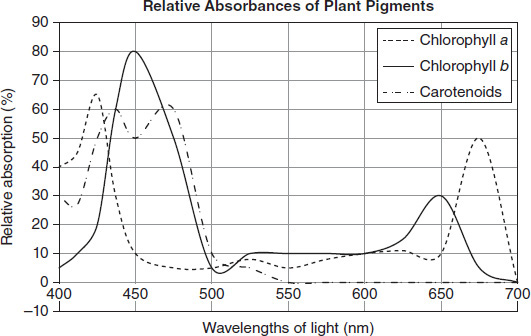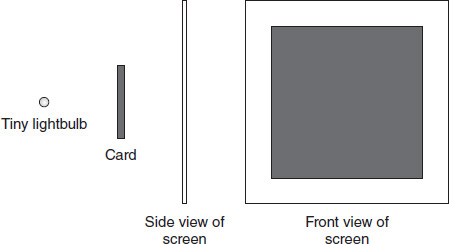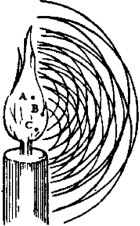
ACT Science Practice Test 30
Đề thi nằm trong bộ sưu tập: Tuyển Tập Bộ Đề Thi Đại Học Hoa Kỳ (ACT) - Có Đáp Án Chi Tiết
Số câu hỏi: 18 câuSố mã đề: 1 đềThời gian: 1 giờ
217,894 lượt xem 16,756 lượt làm bài
Xem trước nội dung:
Photosynthesis is the process by which organisms such as green plants, algae, and cyanobacteria convert light energy from the sun to chemical energy stored in the bonds of carbohydrates. Chlorophyll is a pigment employed by many autotrophic organisms to absorb the various wavelengths of visible light from the sun for use in photosynthesis. A variety of photosynthetic pigments exist; they are specifically adapted for absorbing different ranges of the visible light spectrum and reflecting others. The absorption spectrum of chlorophyll and accessory pigments can be obtained through spectrophotometry and later used to gain insight into plant growth, determine the abundance of photosynthetic organisms in fresh- or saltwater, and evaluate water quality.
The data in Figure 11.1 and Table 11.2 were collected by students measuring the absorption spectra of three commonly encountered photosynthetic pigments.

Figure 11.1
TABLE 11.2

Which of the following statements represents a valid assessment of the data?
Chlorophyll ab
Neither chlorophyll a,b,
Chlorophyll ab
Carotenoids absorb the most light in the red portion of the spectrum.
Using the information in Table 11.2, which of the following wavelengths of light would phycocyanin, a pale blue-colored accessory pigment, reflect most?
400 nm
460 nm
550 nm
750 nm
Based on Figure 11.1, which of the following wavelengths of visible light would be absorbed to promote the most photosynthetic activity in green plants?
400 nm
440 nm
550 nm
625 nm
Based on the information in Figure 11.1 and Table 11.2, which pigment has the highest relative absorbance in the red portion of the spectrum?
Chlorophyll a
Chlorophyll b
Carotenoids
All pigments absorb the same amount of light in this portion of the spectrum.
Which of the following statements about the relative absorbance levels of the pigments is most accurate?
Chlorophyll ab
Carotenoids behave similarly to chlorophyll ab
Chlorophyll b
Carotenoids absorb approximately 60% as much light as chlorophyll b
Which pigment would absorb the most violet light at a wavelength of 425 nm?
Chlorophyll a
Chlorophyll b
Carotenoids
All pigments absorb violet light equally.
Which wavelength represents the maximum absorbance of chlorophyll b?
425 nm
450 nm
515 nm
650 nm
From the information in the passage, one can conclude that chlorophyll appears green to the human eye because:
wavelengths of light between 550 and 600 nm are highly absorbed.
wavelengths in the green portion of the visible spectrum are absorbed.
wavelengths in the green portion of the visible spectrum are reflected.
wavelengths in the red portion of the visible spectrum are reflected.
Phycoerythrin is a photosynthetic pigment that is found in marine algae. It has absorption peaks at 495 nm and 566 nm and reaches its lowest values over 600 nm. Based on this information, one would expect phycoerythrin to:
appear very similar to chlorophyll ab
reflect green light and absorb red light.
reflect red light and absorb green light.
absorb red and green light equally.
In the late 1600s, scientists developed theories about the nature of light. Sir Isaac Newton theorized that light consisted of tiny particles. Christiaan Huygens, on the other hand, believed that light consisted of waves. What do we know about particles? Particles are small, localized objects that typically have certain physical properties like mass, color, or volume. They move in straight lines unless some outside force is acting on them.
Waves, on the other hand, consist of energy that moves through a medium (material). When waves hit a boundary from one material into another, some of that energy bounces back into the original material (reflection); some of the energy moves into the new material (refraction or transmission); and some of the energy transfers to thermal energy through heating (absorption). When waves encounter one another, they will increase in size and strength if similar parts of them overlap (constructive interference) and will decrease in size and strength if opposite parts of them overlap (destructive interference); after the interference, the waves continue moving in their original direction. Waves also spread out (diffract) when they hit a sharp edge or a tiny opening.
The front view in Figure 11.2 shows the image projected on a screen by the light from a tiny lightbulb placed in front of a square card. What can you conclude about the nature of light from the image shown?

Figure 11.2
Light behaves like a wave because it moves in all directions from the lightbulb.
Light behaves like a wave because it does not move through the card.
Light behaves like a particle because it moves in straight lines from the bulb to form the larger shadow on the screen.
Light behaves like a particle because it reflects, refracts, and absorbs in this scenario.
Which of the following does NOT support Huygens's wave theory of light?
A laser light reflects off a mirror and strikes the wall in the back of the lab.
Light hits a black shirt and heats it up.
Sunlight transmits through a thick pane of glass, illuminating a room.
The smallest unit of light is a bundle of energy called a photon.
In the 1600s, it was believed that waves required a medium to travel. Which of the following observations did Huygens have difficulty explaining with his wave theory?
Light travels from the sun to the earth through the vacuum of space.
Light spreads out when it encounters a thin slit in a sheet of paper.
When light hits an opaque surface, the surface heats up.
White light separates into a rainbow of colors when it strikes a prism.
In the early 1800s, Thomas Young shone light through two tiny slits and observed an image on the screen that consisted of many regions of alternating bright and dark patterns. This provided evidence that light is:
a wave because the light from one slit overlapped with the light from the other slit in areas that were strong and weak.
a particle because it was able to make it through the two slits.
a wave because it refracted through the slits, bent in multiple directions, and reflected and absorbed at the screen.
multiple particles bouncing off the slits and moving to certain locations on the screen to make the bright areas and avoiding the dark areas.
When a laser beam of light strikes a penny, one might expect a sharp shadow to form. Instead, a circular, fuzzy-edged shadow forms with a bright spot in the middle. Which of the following best explains this phenomenon?
Laser light particles move in straight lines, and some of those particles are blocked by the penny.
The beam of laser light is a result of stimulated emission of electrons, and the electron particles are able to travel through the material of the penny.
The light bounces off the edge of the penny and hits the middle of the shadow, causing the bright spot.
The light diffracts around the sharp edge of the penny and interferes constructively at the center of the penny.
Figure 11.3 was most likely created by Huygens because:

Figure 11.3
Source: Christiaan Huygens, Treatise on Light. Translated by Silvanus P. Thompson. The Project Gutenberg eBook, http://www.gutenberg.org/files/14725/14725-h/14725-h.htm#Page_4.
the circles show the pathways that particles take when they leave the candle flame.
light is moving in all directions from the candle flame.
the circles coming from Points A, B, and C are like ripples in a pond.
light is coming from different points on the candle flame.
Is the following more likely to be attributed to Newton or Huygens and why?
If you consider the extreme speed with which light spreads on every side, as well as the fact that when it comes from different regions-even those directly opposite-the rays traverse one another without being hindered, you may well understand that when a person sees a luminous object, it cannot be by any transport of matter coming to that person from the object, in the same way that a shot or an arrow flies through the air. Therefore, light must spread in some other way, and that which can lead us to comprehend it is the knowledge we have of the spreading of sound in the air.
Newton, because of the reference to the way light spreads
Huygens, because it claims that light cannot travel like matter does
Newton, because the emphasis is on the extreme speed of light
Huygens, because it explains how we can see images of luminous objects
In the 1900s, Albert Einstein and others determined that the basic unit of light consists of a photon. Among other properties, this unit has a fixed amount of energy, depending on its location on the visible color spectrum. The fact that light can be broken down to fixed units is most consistent with:
Newton's particle theory of light.
Huygens's wave theory of light.
Newton's wave theory of light.
Huygens's particle theory of light.
A beam of direct sunlight moves along an axis through the middle of two polarizing filters, where the axis remains perpendicular to the filters. When the light passes through the first polarizing filter, its brightness reduces to 50%, regardless of its orientation. The light will remain at the same brightness after the second polarizing filter if that filter is aligned the same way as the first. If the second filter twists, however, the light passing through it will gradually be eliminated. Which of the following statements CANNOT be supported by this information?
Because wave energy may be absorbed at a boundary, it is feasible that only 50% of the light energy passes through the first filter.
Light particles may be blocked by objects, therefore it is feasible that only 50% of the light passes through the first filter.
Polarizing filters may be used to control the intensity of light.
The change in the light intensity as the second filter is rotated may be explained by the particle theory of light.
